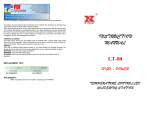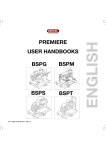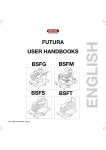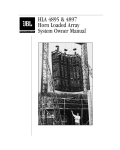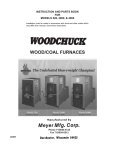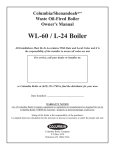Download ALASKA 140 PADDLE FEED Owner`s manual
Transcript
INSTALLATION /OWNER’S MANUAL for KAST CONSOLE III, CHANNING III, LIBERTY, MODEL 140 PADDLE FEED, MODEL 140 AUGER FEED STOVE COMPANY STOVE COMPANY Established 1977 3162 Columbia Blvd., Bloomsburg PA 17815 TURN TO LAST PAGE IN MANUAL FOR CLEARANCE SPECIFICATIONS! MODEL 140 AUGER FEED CAN BURN COAL OR PELLETS CHANNING III, CAST CONSOLE III, LIBERTY, MODEL 140 (STANDARD FEED) ARE FOR COAL ONLY UNDERSTANDING YOUR STOKER STOVE Your Stoker Stove operates utilizing “continuous air” with a time feed mechanism. The advantage of a constant air feed system over any thermostat type operations are: 1) A longer burning season. 2) Your fuel burns better. 3) The auto heat control box allows you to increase and decrease fire size. NOTE: Chimney should match stove exhaust pipe size. CAUTION: STOVE DOORS MUST REMAIN CLOSED AT ALL TIMES WHILE STOVE IS IN OPERATION. Entire vent system should be cleaned at least ONCE PER MONTH. Fossil fuel burning can create lethal doses of carbon monoxide gas. This gas has no odor or color. Purchase a carbon monoxide alarm for detection. Have your chimney cleaned professionally before burning any coal stove. 5/06 FEEDER ASSEMBLY Locate unit (See Fig. 1 on page 3 and Fig. 2 on page 2). Check that strongback gasket is positioned properly as shown in Fig 1. The strongback gasket position is critical in that it prevents air escape to the hopper area which could result in “hopper fire” or warpage to the overplate. The cast iron grate should sit snug to the housing. The gear motor moves the feed bar in a paddle like fashion, to push the coal across the grate. A separate motor with a plastic fan blows air through the grate for the combustion process. Wiring should be connected as shown below. FEEDER ASSEMBLY PARTS LIST 1. Auto Heat Control Box 2. Feeder Housing 3. Grate 4. Half Moon Feed Paddle 5. Plastic Wheel (Combustion Wheel) 6. Airmotor Tray 7. Cover Plate Bolt 1/4" x #20 x 2" 8. (4) #10/32 Nuts 9. Ball Joint Feed Arm 10. Feed Motor 11. Feed Motor Block 12. 1/2 Moon Feed Block 13. (2) 1/4" x #20 Wing Nuts 14. Strongback Gasket 15. Removable Feed Motor Tray 16. Airmotor / Combustion Motor 17. Grate Gasket 2' X Channel Gasket 18. Triple Plug Adapter 19. Paddle Plate (Note: 2 screws w/nut 3/8" x flat head not shown) 20. (2) 1/4" x #20 x 1" cap screws 21. Grease Fitting 22. 4' x 3/8" Rope Gasket WIRING: Locate plug connections below, connect the male and female plugs with matching letters (example A.M. to A.F.) connect C.M. to a 110 volt wall outlet. NOTE: Your feeder unit should come to you fully assembled and ready to plug in. RHEOSTAT - is used to control the speed of your air distribution fan and allows you the air push you desire. NOTE: Strongback is gray in color. make sure it’s pinched between the grate and the feeder housing. As shown below. IMPORTANT: Paddle should be greased at least twice per year with standard grease (see grease fitting position below). Grate gasket should be applied to feeder housing. Hopper Gasket 4 22 19 B.M. B.F. 10 2 C.M. 1 FIGURE 2 2 14 17 21 3 Grate Air Holes In Grate 16 FIGURE 1 6 15 12 20 2 CM AF 8 18 9 11 AM 3 5 7 PADDLE FEED ADJUSTING THE FIRE SIZE - The Auto Heat Box is your fire size control. The box is numbered 1 to 5. Generally a setting of 1 will maintain a minimum fire. A setting of approximately 5 will give you a full efficient fire (85,000 BTUs). A setting of less than 1 may cause your fire to go out. A setting of over 5 may cause hot burning coals to spill off the grate before it is fully burned. Select a setting between the low burn of 1 and the high burn of 5 until your home is comfortable. Allow ample time for fire to adjust. A maximum fire should not exceed and inch of ash on the end of the grate. AUGER FEED Auto heat box for the Auger Feed may be adjusted higher than the 5 setting to achieve a full fire. Read this page before installing your stove. READ ENTIRE MANUAL • Masonry or factory built class “A” chimney may be used. A height of at least 15' from floor to top of chimney with an inside opening of a least 6" is required. • This Stoker can also be installed using our “Alaska Vent” system. Ask your dealer for details. • Make sure your chimney is free of any obstructions. The clean out door should be sealed and securely attached. Have your chimney cleaned and inspected before starting your stove. • Be sure to purchase and install a carbon monoxide detector before you start to burn your stove. • Contact your local building code officer, or your fire safety inspector to insure you’re in compliance with local codes as they can vary. • Alaska Company recommends that you install your stove with a Barometric Damper. We also recommend a minimum draft of .04" of water column, although this stove may draft at lower measurements. It may not function properly, by following these requirements it will help regulate your draft in high wind conditions and allow your stove to burn more efficiently. • Fresh air is important to the function of your stove, an over insulated (air tight) house may not allow enough combustion air for the proper performance of your stove. This can be corrected by slightly opening a window or installing a fresh air inlet. • Glass Cleaning and Care - Stove glass is high temp ceramic which can be fragile. Do not use cold water to clean. Do not slam door shut as fracturing could occur. Abrasive cleaners will scratch the glass. Do not clean glass while hot. Use a ceramic glass cleaner and soft cloth. • Brass and Gold Plating Care - Be sure to clean all fingerprints and oils from these surfaces before lighting your stove. Do not use an abrasive cleaner. Denature alcohol and a soft cloth are suggested. Any other cleaning products should be used according to the manufacturer’s instruction. CAUTION: If you are installing your Stoker Stove in a basement and your home uses a “heat pump” system, return air must be provided to the basement area. EXAMPLE: Do not pull air out of the basement with provision for return air or you could reverse the chimney draft of the stoker causing sulfur dioxide and carbon monoxide to enter living area. ASSEMBLY OF TOP VENT KAST CONSOLE III, CHANNING III NOTE: Most stoves are preassembled. STEP 1 Remove all parts from box and stove body. Locate feeder plate (See Fig. 3). Remove the 4 bolts from the feeder plate. Align the feeder assembly with the holes in the feeder plate. Insert the 4 bolts and tighten. follows: Place a washer over bolt. Insert bolt into hole inside hopper. Apply another washer as the bolt comes through the hopper. Put a spacer over the bolt and insert into hole in stove body (Fig. 3) Snug bolt but do not tighten. Affix the 2nd bolt using the same procedure. Press down on the hopper to set into the gasket. Tighten the 2 bolts. STEP 2 Position the hopper gasket around the top edge of the feeder housing. Locate and remove the hopper bolts and spacers from the back of the stove body (Fig. 3). Place the hopper on the feeder housing. Be sure the 4 tabs on the hopper fit inside the opening of the feeder housing. Bolt the hopper to the stove as STEP 3 Blower attachment - Placer blower under angle bracket. Insert bolts and tighten. STEP 4 Remove Viewing Door from stove body. 4 Locate Glass Box which will include gaskets and instructions. Install glass. Re-hang door. NOTE: Some models come with glass installed. If your stove is ordered with the optional clean glass system, locate stainless steel screen (packed inside stove body). This screen helps to prevent fly ash from attacking the glass. Install the screen so the bottom rests on the Channel inside the stove body below the View door, and the top will lean against the metal plate welded to the top of your stove. NOTE: Install screen after stove is lit. Use hearth or stove gloves to install screen. Top Vent Stove Only - This unit is sent to you with a brick attached to the inside back of stove. This component is removable which serves two purposes: a) Slide brick, opens for cleaning of fly ash and to allow you to adjust for better draft on warm days (Keep closed in colder months. Slide open in warmer months.) b) For access to clean the stove’s vent system. Please locate brick at this time. Open viewing door, look inside stove through door opening. The brick will be between two metal channels, about 4" from the top of your stove. Locate holes in back of stove body. This is where your stove vents. The two holes should be cleaned every 4 to 6 weeks with a vacuum or brush. NOTE: Entire vent system should be cleaned every 4 to 6 weeks. This may vary depending on chimney draft. STEP 5 Attaching Power Cords - Plug the female cord from the rheostat into the male cord coming from the blower. NOTE: The rheostat acts as a speed control and an off/on switch for the blower. It can be attached to the side of the hopper or wall using Velcro tape. Plug the male end of the feeder cord into a 110v wall outlet (See Fig. 2 C.M.) STEP 6 Position Stove - Align stove pipe and screw pipe to vent hole (See Assembly of Stove Pipe). STEP 7 Place the steel of optional cast top on stove. If you have a Kast Console III model, the top comes in 3 pieces. Position the center piece first, then the sides. Channing III has a single piece tope. INSTALLATION GUIDE FOR ALASKA THERMOSTAT SYSTEM STEP 1 Locate wall thermostat and thermostat control box. Plug timer control box into Feeder/Feeders. Attach timer control box securely to hopper or wall. STEP 2 Light stove as described in stove manual. Be sure thermostat wire leads are not connected together. Adjust lower knob, to number 4 and allow fire to stabilize. Adjust lower knob down allowing 15 to 20 minutes between adjustments until you have about 1 inch of burning coal on the grate from side to side. STEP 3 Connect thermostat wire leads together. Adjust top know to number 4. Allow fire to stabilize. Slowly adjust upper knob higher, until desired fire size is achieved. STEP 4 Disconnect thermostat wire leads. Run wire to desired location, attach wall thermostat. Adjust wall thermostat to desired temperature. NOTE: Low fire and high fire setting may vary depending on desired heat output. 5 COAL OR PELLET FUEL BURNING SYSTEM ASSEMBLY NOTES The Model 140 is pre-assembled, except for the blower. Follow Page 8, Step 5 for blower assembly. The Model 140 may also be disassembled allowing the unit to be placed through small door openings and cellar entrances. CAUTION: Care must be taken during reassembly. Improper assembly may cause smoke leakage or a hopper fire. REINSTALLING THE HOPPER STEP 1 Make sure gasket on hopper casting is in good condition. STEP 2 Place hopper on hopper casting, center hopper, attach bolts and tighten. STEP 3 Make sure there are no spaces or gaps between base of hopper and top of hopper casting. *See Page 9 for Installation Instructions OPERATING INSTRUCTIONS AUGER FEED SYSTEM NOTE: All fuel, coal or pellet must be thoroughly cleaned from feed system before switching from one fuel to another. NEVER USE SOAKING WET COAL! Soaking wet coal will cause condensation in the hopper. PELLET BURNING STEP 1 Fill hopper with pellets. Plug auger feed system into 110V outlet. Turn auto heat box knob clockwise until it stops. Allow pot to fill about half way, then turn auto heat box to 3. COAL BURNING STEP 1 Fill hopper with dry coal. Plug auger feed system into 110V outlet. Turn auto heat box knob clockwise until it stops. Allow pot to fill with coal, then turn auto heat box to 3. STEP 2 Turn combustion blower off. STEP 3 Light pellets (use a propane torch or alcohol gel.) STEP 2 Light fire as instructed. See page 10. STEP 4 After pellets are burning, turn combustion blower to the low setting. Adjust auto heat knob to desired position. With 1 being approximately a low fire, turn knob clockwise until it stops. This is approximately a full fire. NOTE: These settings are approximate and will vary. STEP 3 Use the high setting for combustion blower when burning coal. STEP 4 Hopper lid must be shut and latched for auger feed system to operate (make sure hopper lid seal is kept in good condition.) NOTE: SEASONAL / END OF YEAR CLEANING STEP 1 Empty hopper. STEP 5 Adjust auto heat knob to desired position. With 1 being approximately a low fire, turn knob clockwise until it stops. This is approximately a full fire. NOTE: These settings are approximate and will vary. STEP 2 Empty auger. STEP 3 Remove ash dump bolt and plate. Vacuum all ash from pot casting. (This may need to be done during burn season). STEP 4 Clean pipe and elbows several times during burn season. 6 FEEDER ASSEMBLY PARTS LIST 1. 2. 3. 4. 5. 6. 7. Feed Motor Auto Heat Control Box Auger 6 Piece Grate System Ash Dump Plate 2 Speed Combustion Blower Auger Hub 8. 9. 10. 11. 13. 14. Auger Shaft Collar Motor Stop Support Bracket Ash Ring Pot Casting Hopper Casting Combustion Blower Shut Off Switch ABOUT THE AUGER FEED SYSTEM The Auger Feed System is capable of burning rice coal or wood pellets. The fuel is fed from the hopper through the auger and out of the burn pot. Unburned fuel residue is either blown out of the pot by the 2 speed blower or forced out by fresh unburned coal. ADJUSTING THE FIRE SIZE The fire size is regulated by the Auto Heat Box. The box is numbered. The approximate minimum fire number is 1. The knob may be turned higher than the 5th setting as long as hot or burning coals are not being forced off the edges of the grate. This is the approximate highest fire setting. 7 ASSEMBLY OF YOUR MODEL 140 adhesive on gasket. Place gasket around outside top of blower. Locate blower shroud, place blower shroud over blower and attach with screws. NOTE: The stove comes assembled. STEP 1 Remove all parts from inside the stove body and the parts box. Remove the 8 bolts from the frame of the feeder plates (4 from each plate). Align Feeder Assembly holes with feeder plate holes. Insert bolts and tighten (See Fig. 6). If you purchased a Model 140 with one feeder, mount the feeder plate cover over one opening. STEP 6 Refer to drawing for approximate location of wiring harness bracket. Hold bracket in position, attach with self-taping screws provided (See Fig. 7) Plug blower motor into the junction box cord (long female cord). Plug feeder(s) into short female cord (use triple plug adapter if stove is ordered with 2 feeders). Plug into a 110 volt receptacle and test for motor operation (See Fig. 8). (If you purchased Model 140 with optional hot air fan limit switch, instructions are contained in box). Your Model 140 can be used as a hot air system. Contact your Alaska dealer for details. Cold air return may be accomplished by returning air into immediate area of distribution blower. A box could be constructed over the blower and cold air returns. Connect pipe to ensure fit. Place 3 screws at each joint. We also recommend a bed of high temperature silicone at each joint (optional), once your stove is positioned properly attach pipe at top of stove. STEP 2 Place Hopper Gasket around Top edge of Feeder Housing. STEP 3 Remove hopper bolts and spacers from jacket above feeders. STEP 4 Place hopper over openings in the feeder assemblies, the hinged lid toward the stove body (See Fig. 7). Place a bolt with a washer though the hole from inside the hopper, add a washer and a spacer on bolt, thread into stove body. Use same procedure for second bolt. Push down on hopper to seat firmly on gasket. Tighten the bolts. The hopper tabs should be inside the feeder housing (Fig. 6). If you have purchased a one feeder unit, use the hopper plate cover to seal the open hopper opening. STEP 7 Remove view door from stove body. Locate glass box which will include gasket and instructions. Install glass. Re-hang door. NOTE: The rheostat on the wire harness bracket is to control the speed of your air distribution fan. Allowing for more or less air push. STEP 5 Install blower - locate blower hole at bottom back of stove. Remove the 1/4"x20x1/2" self threading screws. Position blower in hole and attach with screws. Locate 2'x3/8" Rope Gasket. Remove cover tape from 8 ASSEMBLY OF YOUR MODEL 140 STEP 1 Place stove body on hearth. Allow proper clearance to flammable surfaces. See last page for clearances. STEP 2 Place a piece of pipe over the vent hole, crimped end up. For Model 140 an elbow may be placed on the stove body (See Fig. 8). STEP 3 Locate Barometric Damper (See Fig. 5). Assemble and set in accordance with manufacturer’s directions. Proceed as follows: Model 140 - Place barometric damper on elbow, crimped end up, pointed in the direction of thimble from the chimney (See Fig. 8). Top Vent Stove - Place barometric damper over the pipe already on stove. Be sure your attachment is plumb. (See Fig. 5). STEP 4 Place a length of pipe into Wall Thimble (See Fig. 4). This pipe should go through wall and into the Flue Liner. Do not allow pipe to pass through the flue liner. Seal all openings where pipe entered wall with fiberglass. Place “Trim Collar” over pipe and snug tight to wall (See Fig. 4). STEP 5 Place an elbow into the pipe coming out of wall, take a measurement from the top end of the barometric damper to the bottom of the elbow - add 3" to your measurements. This will be the length of pipe you will need cut (if necessary) and assemble. NOTE: We suggest an initial Barometric Draft Setting of .04. Once your fire is burning, check manufacturer’s directions before final adjustment - use Rc-Bt Ul Listed Barometric if available. 9 STARTING YOUR STOKER STOVE FIRE CAUTION: Dry out your masonry chimney before starting your stove. occur and to allow time to understand your stove. 1) Fill hopper with dry coal 2) Dry out your masonry chimney with a separate wood kindling fire for twenty minutes. Build this fire in cleanout door or on bottom of stoker. 3) Mount your Auto Heat control box securely to a wall near your stove. Do not mount on stove body! 4) Place fire starter on grate, cover with coal, light tail close viewing door and wait until starter head is burning. 5) Plug power cord into your wall outlet. 6) Set your “Auto Heat” dial to setting #2. 7) In 20-30 minutes your fire becomes fully established. 8) Adjust your Auto Heat dial to your comfort REMEMBER - a setting of 1 is approximately a low fire. CHIMNEY SYSTEM - Make sure it is clean and free of any debris. Moisture in a new chimney or a cold chimney does not allow for proper drafting of flue gas. Dry out and warm up a chimney by: • Open clean-out door, build a small wood fire for ten minutes. OR place wadded newspaper on floor of Stoker and burn paper for 10 minutes… Add paper as needed. • If you should smell sulfur at any time - Turn the unit off - Open doors and windows. • Initial burning of your stove will cause the paint to cure (smoke). Ventilate area by opening window. • If your home is well-insulated, have a fresh air inlet installed - open a window (1") while your stove is operating. • On your first day of operation, we suggest you start your stove early in the day to allow the curing process to Always operate stoker with both doors closed. Always test your gas alarm as per instruction. BEFORE YOU CALL US… Not Enough Heat • Make sure space between the hopper and stoker is clear of coal. • Make sure gasket is intact. • Make sure stove pipe is clear of fly ash. • Important - check elbow closest to stove. • On Channing III clean behind draft tubes by grate. • Check to see if holes in grate are clogged… clean. Make sure under grate is free of coal fines. This can be done by lifting the grate off the feeder housing. CAUTION: Make sure when replacing grate, the gasket material is in place both around the bottom of grate and on rear of grate (See Fig. 3). • Make sure there are no cracks in grate. • Make sure plastic wheel on gear assembly is intact and clean of any dirt or dust Hopper Fire • Do you have a Barometric Damper on Stove? • Check grate - is there a crack? • Is the gasket and/or strongback intact on grate? • Is gasket between feeder and hopper missing? • Check size of coal - it might be too large. You should use rice coal. Black Dust • Dirty coal or dry coal should be dampened. • Turn off blower rheostat or unplug main cord when pouring coal into hopper or changing ash buckets. • Make sure air space is between top of stove and main stoker body is clear of coal dust. Moisture in Hopper • Check behind slide brick for fly ash buildup. • Do you have excessively wet coal? • Is your stove pipe blocked? • Do you have good draft? • Remove Pipe; clean exhaust holes. Sulfur Fumes • Make sure hopper is not being filled with soaking wet coal. NOTE: Allowing moisture to build up in Hopper will cause rusting and severely damage your feed system, voiding all warranties. INSTALL A GAS ALARM!!! 10 END OF YEAR CLEANING AND MAINTENANCE 1. Remove the exhaust pipe. Thoroughly clean and place in a dry location during nonburning months. Clean exhaust tubes in stove body of all debris. 2. Remove coal from stove and vacuum clean. 3. Thoroughly brush inside of stove body, free of all fly ash and vacuum clean. 4. Remove the Half Moon Paddle from feed tray, (loosen the two setscrews at bottom of paddle allowing feed arm to drop down). Pull Paddle out from top of feed tray, clean shaft, lubricate, and reinstall. 5. Locate grate inside stove, clean all holes. 6. Locate Air Motor Tray. Remove bolt from bottom of tray, disconnect wiring, and remove air motor tray. Thoroughly clean motor and plastic combustion wheel. Vacuum under grate through hole where air motor tray was removed. Replace air motor tray, wiring and bolt, Do Not Over Tighten Bolt! 7. Locate distribution blower. Thoroughly clean motor and wheel of dust. 8. Inspect all gaskets and replace if necessary. Note: All gaskets should be replace every three years. 9. Remove top of stove, Thoroughly clean inner top, replace top. 10. Lightly spray WD-40 inside only of stove body. 11. Let stove stand for a few minutes. After stove has ventilated adequately place a low watt lit bulb inside stove body. This will aid in keeping dampness out of stove. NOTE: Important!! If grate has been removed make sure gaskets are installed properly. See Page 2 Figure 1. ALASKA COMPANY, INC. BLOOMSBURG, PA 17815 MODEL: KAST CONSOLE, CHANNING, LIBERTY Quality Since 1977 STOVE COMPANY FUEL COAL SERIAL NO. U.S. ENVIRONMENTAL PROTECTION AGENCY THIS HEATER IS ONE FOR BURNING COAL. USE OF ANY OTHER SOLID FUEL EXCEPT FOR COAL IGNITION PURPOSES IS A VIOLATION OF FEDERAL LAW CONAM Inspection, Inc. Auburn, MA 01501 STL - 002 Tested 2/97 to ANSI/UL, CSA B366-1979 & ETLM 781 CHIMNEY TYPE: MINIMUM 6 INCH DIAMETER APPROVED LOW HEAT RESIDENTIAL TYPE ALL FUEL. CHIMNEY CONNECTOR: 6 INCH DIAMETER 24 GAUGE BLUE OR BLACK STEEL. INSTALL AT LEAST 4 INCHES FROM WALL AND 6 INCHES FROM CEILING. SPECIAL METHODS ARE REQUIRED WHEN PASSING THROUGH A WALL OR CEILING. SEE INSTRUCTIONS AND BUILDING CODES. SEE DIAGRAM. 4" 2" 10" HOPPER HOPPER STOKER 18" FRONT FLOOR PROTECTOR MINIMUM SIZE TOP VENT CORNER INSTALLATION 8" 8" STOKER HOPPER 6" 8" STOKER 18" FRONT FRONT INSTALL WITH MINIMUM CLEARANCE TO WALL AS SHOWN (IN INCHES) 16" 13" 6" 13" H O PP ST ER O K FR ER O N T REAR VENT USE APPROVED FLOOR PROTECTOR CONTACT YOUR LOCAL BUILDING OR FIRE OFFICIALS ABOUT RESTRICTIONS AND INSTALLATION INSPECTION IN YOUR AREA 11 MODEL: 140 PADDLE FEED FUEL COAL SERIAL NO. MODEL 140 AUGER FEED COAL OR WOOD PELLET Quality Since 1977 STOVE COMPANY ALASKA COMPANY, INC. BLOOMSBURG, PA 17815 U.S. ENVIRONMENTAL PROTECTION AGENCY MODEL 140 SINGLE/DUAL FEED HEATER IS ONLY FOR BURNING COAL. USE OF ANY OTHER FUEL EXCEPT FOR COAL IGNITION PURPOSES IS A VIOLATION OF FEDERAL LAW. MODEL 140 AUGER HEATER IS ONLY FOR BURNING COAL/PELLETS. USE OF ANY OTHER SOLID FUEL EXCEPT FOR COAL/PELLETS IGNITIONS PURPOSES IS A VIOLATION OF FEDERAL LAW. MODEL 140 CONAM Inspection, Inc. Auburn, MA 01501 STL - 002 Tested 2/97 to ANSI/UL 1482, CSA B366-1979 & ETLM 78-1 CHIMNEY TYPE: MINIMUM 6 INCH DIAMETER APPROVED LOW HEAT RESIDENTIAL TYPE ALL FUEL. CHIMNEY CONNECTOR: 6 INCH DIAMETER 24 GAUGE BLUE OR BLACK STEEL. INSTALL AT LEAST 8 INCHES FROM WALL AND 6 INCHES FROM CEILING. SPECIAL METHODS ARE REQUIRED WHEN PASSING THROUGH A WALL OR CEILING. SEE INSTRUCTIONS AND BUILDING CODES. 8" 18" FLOOR PROTECTOR 140 & STOKER STOVE II 18" 8" 8" STOKER HOPPER FRONT INSTALL WITH MINIMUM CLEARANCE TO WALL AS SHOWN (IN INCHES) STOKER & HOPPER B A= 16" for model 140 8" for Stoker Stove II A FRONT B=8" for model 140 16" for Stoker Stove I PREVENT HOUSE FIRES: INSTALL AND USE ONLY IN ACCORDANCE WITH THE MANUFACTURER’S INSTRUCTIONS AND LOCAL BUILDING CODES ALASKA STOVE COMPANY - LIMITED WARRANTY This warranty applies only to the original purchaser. Purchase must be made through an authorized Alaska Co. dealer or a representative of the Alaska Co. The following warranty applies from the date of purchase. Workmanship of body ten years, castings two years, gear motor two years, all other electrical parts one year, glass and ash pan are not warranted. Warranty does not apply if damage occurs because of accident, improper handling or operation, abuse, misuse, rust or corrosion. No unauthorized repair should be made or attempted. Freight and labor costs incurred or any authorized, warranted item are the responsibility of the original purchaser. All warranty claims must be accompanied by a copy of the original sales agreement. To make claims under this warranty. Contact the dealer from whom you purchased this unit. In the event the unit must be returned to the factory for inspection or repairs, the original purchaser must ship prepaid to: Alaska Co., 3126 Columbia Blvd., Bloomsburg, PA 17815 In order for this limited warranty to be effective and binding upon Alaska Co. the following section must be detached, completed and sent by the original owner to Alaska Co., 3162 Columbia Blvd., Bloomsburg, PA 17815 within 30 days of purchase. ***All liability for any consequential damages from breach of any written or implied warranties is disclaimed and excluded here from. Some states do not allow the exclusion or limitations of accidental or consequential damages, so the above limitation or exclusion may not apply to you. This warranty gives you specific legal rights and you may also have other rights which vary from state to state. This warranty is void if you do not return the attached card within thirty (30) days after the date of purchase. ***A term required by Federal Law. Warranty Registration, Cut here and return to: Alaska Company, Inc., 3162 Columbia Blvd., Bloomsburg, PA 17815 Check Box for Model: Name: ❑ Kast Console III Address: ❑ Channing III State: ❑ Model 140 Dealer Name: ❑ Liberty Serial # (from label): ❑ Auger Feed 140 Phone: Zip: Purchase Date:













